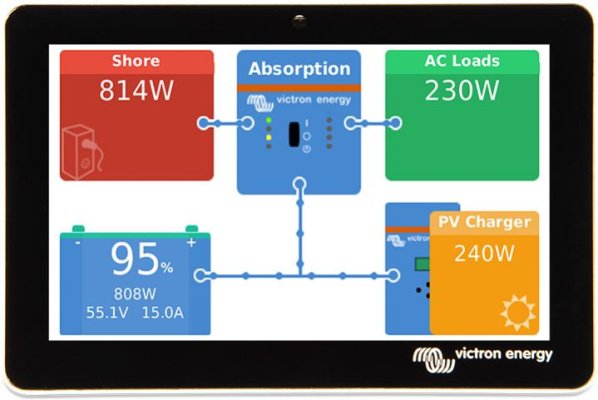.... snip....
The Color Control GX looks pretty and connects to the internet for remote monitoring (with an additional dongle), but it doesn't really allow all that much control. Changing advanced settings (like charging voltage) still requires breaking out a laptop, USB dongle, and ethernet cable.
The inverter/charger itself has been reliable.
Yes, the Colour Control GX is a huge disappointment in relation to 'Control' aspects compared to the Blue Power Panel, its predecessor in mono. With the BPP you could go down menu tree's to program anything you wanted. Now its the dongle etc.
Back in 2012 I installed a Quattro 3000/12/120 inverter-charger, a BPP and a Victron battery controller. The latter 2 are no longer available as far as I know, but were very good products. Unfortunately they are incompatible with the current Quattro firmware. Hence the Colour GX plus a BMV 712. The latter I like a lot.
My old Quattro was trouble free for 6 years, but then developed an intermittent over-heating issue when charging. The inverter was fine fully loaded. My local dealer was eventually, with support from the Netherlands, able to determine it was not repairable and although I could not find out what the issue was they offered me $1000 discount on a new Quattro with same specs. I took that to mean they had found a design fault in the unit. The new unit was somewhat upgraded though, particularly in regard to overload/heat management and firmware was significantly upgraded.
I realised on my first trip with the new Quattro what had happened to the old one. For years I had been able to run the clothes dryer while underway, but the new Quattro (same model specs) tripped when trying to do it. The Quattro unfortunately sits in the ER, and I quickly determined that when underway the combined ER temp and inverter load put the Quattro up to 50°C. It cannot deliver its full 3000VA at that temp! The old unit kept on trying, but eventually cooked something inside itself to the point it was starting to fail.
So, try and keep you house bank and inverter out of the ER if possible. Also, go one size larger (or stack two units if you must) to ensure you get adequate capacity at the ambient temp where they are installed. The VA rating is also somewhat misleading, the actual wattage able to be delivered continuously is lower than that.
For integrating various charging sources, I have decided to set different charge profiles for each source. I have just installed a new AGM battery bank, and it has ranges quoted for absorption and float voltage. So I programmed my Balmar 612 (2 x 200 A alternators) for the top of those ranges to get rapid recharge. I also have solar (2070 W, Outback Controllers) and set a profile to the midpoint of the battery specs. And for shore power, via the Quattro, I set to the bottom of the battery spec range. In this way, when at the dock on shore power for long periods, float voltage is kept low (13.4V) to avoid drying out the AGM's by still trickle charging even when they are fully charged. The Quattro also has a 'storage' mode where voltage is dropped to 13.2V, which I see as a bonus. My final mod was to reduce minimum time for absorption phase of the solar controllers down to 6 minutes. This was to keep the period of high absorption-level voltages to a minimum when solar starts up in the morning at the dock, at a time when shorepower already has the bank fully charged.
So far these profiles are performing the way I had hoped they would. For example, when leaving the dock with fully charged batteries the Balmar dropped alternator charge current back to basically what the engines required to run, and after a short period voltage reduced as well. The solar controllers turned themselves to 'Silent' (off) without any action from me.
I believe Victron offers top quality products. In recent years they have been moving to increase integration and capacity to monitor via bluetooth on a phone, as well as via the internet. Its been a couple of years since I installed the new Quattro, which may by now have the bluetooth connectivity that my unit lacks. If I were doing it all from scratch, I would happily go all Victron where they had products available.
One aspect I might change would be to seperate the charger and inverter functions. Victron make some great chargers that will take any voltage and any frequency. Well, both Euro and USA voltage and Hertz at least. So if you are moving from one country to another with Hertz and voltage differences your shorepower flexibility is enhanced. On the other hand, Victron inverters, and inverter-chargers, are set for just one Hz/V spec only. So changing when moving between countries your shorepower input design gets more complicated.

 .
.


